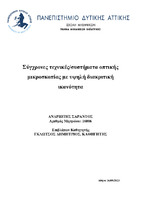| dc.contributor.advisor | Glotsos, Dimitris | |
| dc.contributor.author | Ανδριώτης, Σαράντος | |
| dc.date.accessioned | 2023-11-09T14:32:36Z | |
| dc.date.available | 2023-11-09T14:32:36Z | |
| dc.date.issued | 2023-10 | |
| dc.identifier.uri | https://polynoe.lib.uniwa.gr/xmlui/handle/11400/5630 | |
| dc.identifier.uri | http://dx.doi.org/10.26265/polynoe-5467 | |
| dc.description.abstract | Η παρακάτω εργασία αποσκοπεί στο να διευρύνει τις γνώσεις του αναγνώστη στην μικροσκοπία και συγκεκριμένα στις τεχνικές της υπερ-ανάλυσης. Αρχικά, γίνεται μία αναφορά στις ιδιότητες του φωτός, καθώς η ίδια η μικροσκοπία βασίζεται πάνω σε αυτές. Αυτό συμβαίνει καθώς η κάθε τεχνική μικροσκοπίας αξιοποιεί διαφορετικές ιδιότητες του φωτός για την παρατήρηση του δείγματος, με σκοπό να παρέχουν στον μελετητή τα απαραίτητα δεδομένα που θα τον βοηθήσουν στην μελέτη του. Στη συνέχεια, γνωστοποιείται στον αναγνώστη η σημασία που κατέχει το ανθρώπινο οπτικό σύστημα στην οπτική παρατήρηση, που αποτελείται από τους οφθαλμούς, το οπτικό νεύρο και τον εγκέφαλο. Έπειτα, γίνεται μία αναφορά σε κάποιες από τις απλές τεχνικές μικροσκοπίας που χρησιμοποιούνται μέχρι και σήμερα και σε ποιες ιδιότητες του φωτός βασίζεται η καθεμία. Μετά, αναλύεται το οπτικό όριο που μπορεί να διακριθεί με την χρήση των απλών τεχνικών και που οφείλεται αυτό, το οποίο ήταν και ο λόγος που δημιουργήθηκε η ανάγκη της δημιουργίας των τεχνικών μικροσκοπίας υπερ-ανάλυσης. Ύστερα, αναλύονται οι διάφορες τεχνικές υπερ-ανάλυσης και πως εξετάζουν η καθεμία ξεχωριστά το δείγμα κατά την παρατήρηση του, και τέλος, σε ποια δείγματα είναι προτιμότερο να εφαρμόζεται η κάθε τεχνική από αυτές. Συμπερασματικά, η εργασία τελειώνει αναφέροντας ότι οι τεχνικές υπερ-ανάλυσης πρέπει περαιτέρω να βελτιωθούν, ώστε να αυξηθεί η αξιοπιστία, αλλά και η προσαρμοστικότητα τους στην ποικιλομορφία των διαφορετικών δειγμάτων. | el |
| dc.format.extent | 80 | el |
| dc.language.iso | el | el |
| dc.publisher | Πανεπιστήμιο Δυτικής Αττικής | el |
| dc.rights | Αναφορά Δημιουργού - Μη Εμπορική Χρήση - Παρόμοια Διανομή 4.0 Διεθνές | * |
| dc.rights | Αναφορά Δημιουργού - Μη Εμπορική Χρήση - Παρόμοια Διανομή 4.0 Διεθνές | * |
| dc.rights.uri | http://creativecommons.org/licenses/by-nc-sa/4.0/ | * |
| dc.subject | Τεχνικές μικροσκοπίας υπερ-ανάλυσης | el |
| dc.title | Σύγχρονες τεχνικές/συστήματα οπτικής μικροσκοπίας με υψηλή διακριτική ικανότητα | el |
| dc.title.alternative | Modern microscopy techniques/systems with high resolution | el |
| dc.type | Διπλωματική εργασία | el |
| dc.contributor.committee | Asvestas, Dimitrios | |
| dc.contributor.committee | Kostopoulos, Spiros | |
| dc.contributor.faculty | Σχολή Μηχανικών | el |
| dc.contributor.department | Τμήμα Μηχανικών Βιοϊατρικής | el |
| dc.description.abstracttranslated | The following thesis aims to expand the knowledge of the reader on field of microscopy and specifically on the techniques of super-resolution microscopy. To begin with, there is a reference on the properties of light, since the whole aspect of microscopy is based on them. This happens because every microscopy technique makes use of a different property of light for the observation of the sample, in order to provide the researchers with the necessary data needed to help them with their research. Subsequently, the reader is made aware of the human visual system and how it functions and the parts it consists of, those being the oculi, optical nerve and the brain. Afterwards, some basic microscopy techniques that are still used even nowadays are being mentioned, whilst also explaining which property of light each of them is based on. Then, analysis is done on the optical limit that is discernible with the usage of simple techniques, and why that is. That being the reason for the need, for the creation of the super-resolution microscopy techniques. Following, the different super-resolution techniques are being introduced and how each of them examines the sample provided by the researcher during their observation, and lastly, in which samples is each of them better suited to be used in order to produce the best results possible. To conclude with, the thesis ends on the premise that super-resolution techniques must be further improved, so that both their credibility and their adaptability increases, even when examining a big variety of samples which have different characteristics and properties. | el |


